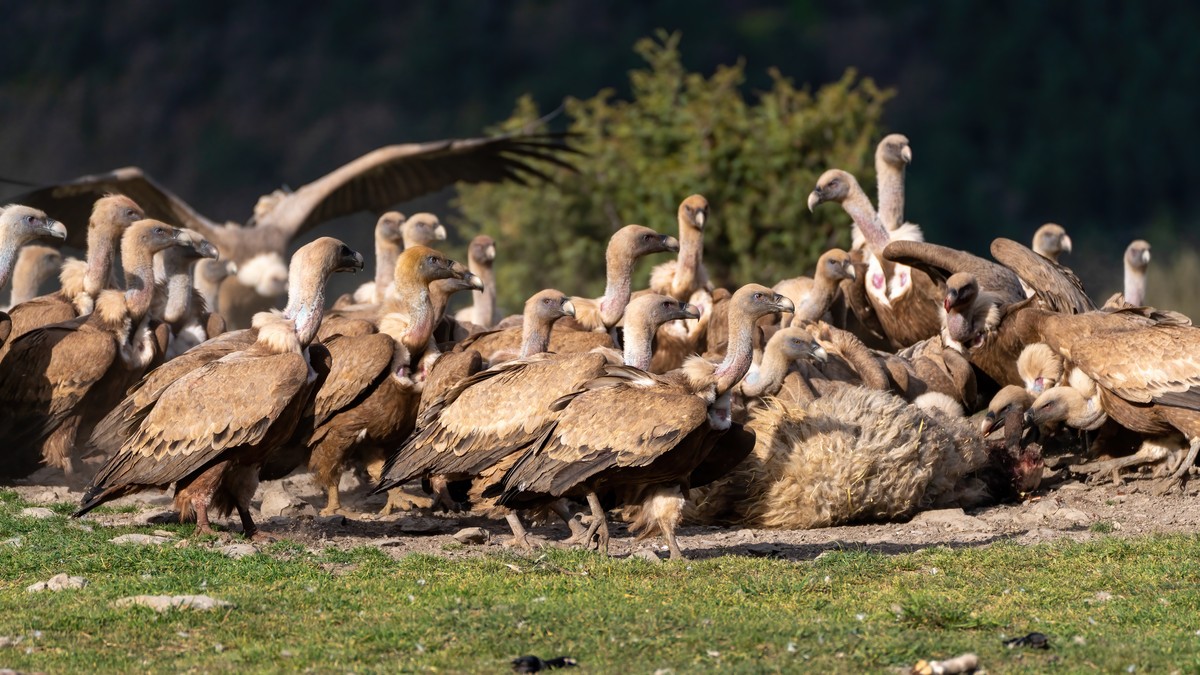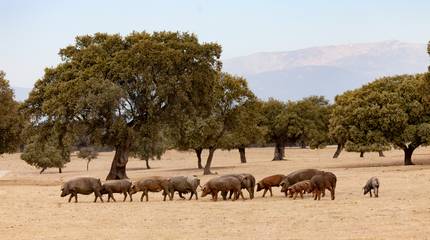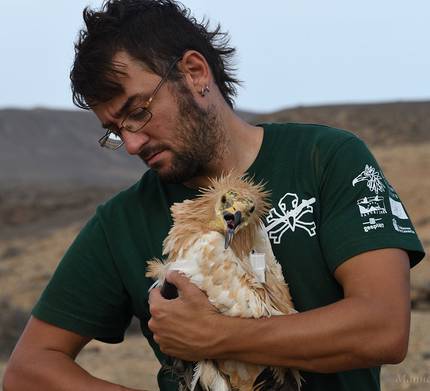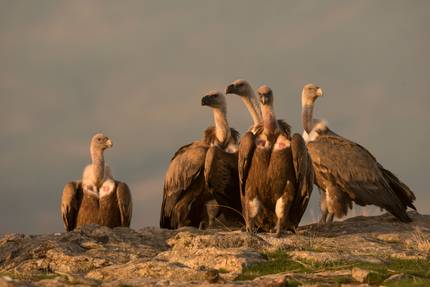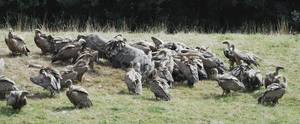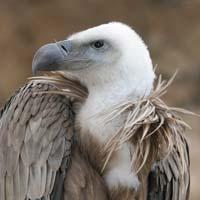Vulture culture
2023/09/01 Etxebeste Aduriz, Egoitz - Elhuyar Zientzia Iturria: Elhuyar aldizkaria
Males and females do not eat the same, neither the northern nor the southern. They're gregarious animals that learn from each other or together. Biologist Eneko Arrondo Floristan has been researching the customs and behaviors of lions and has made eye-catching discoveries.
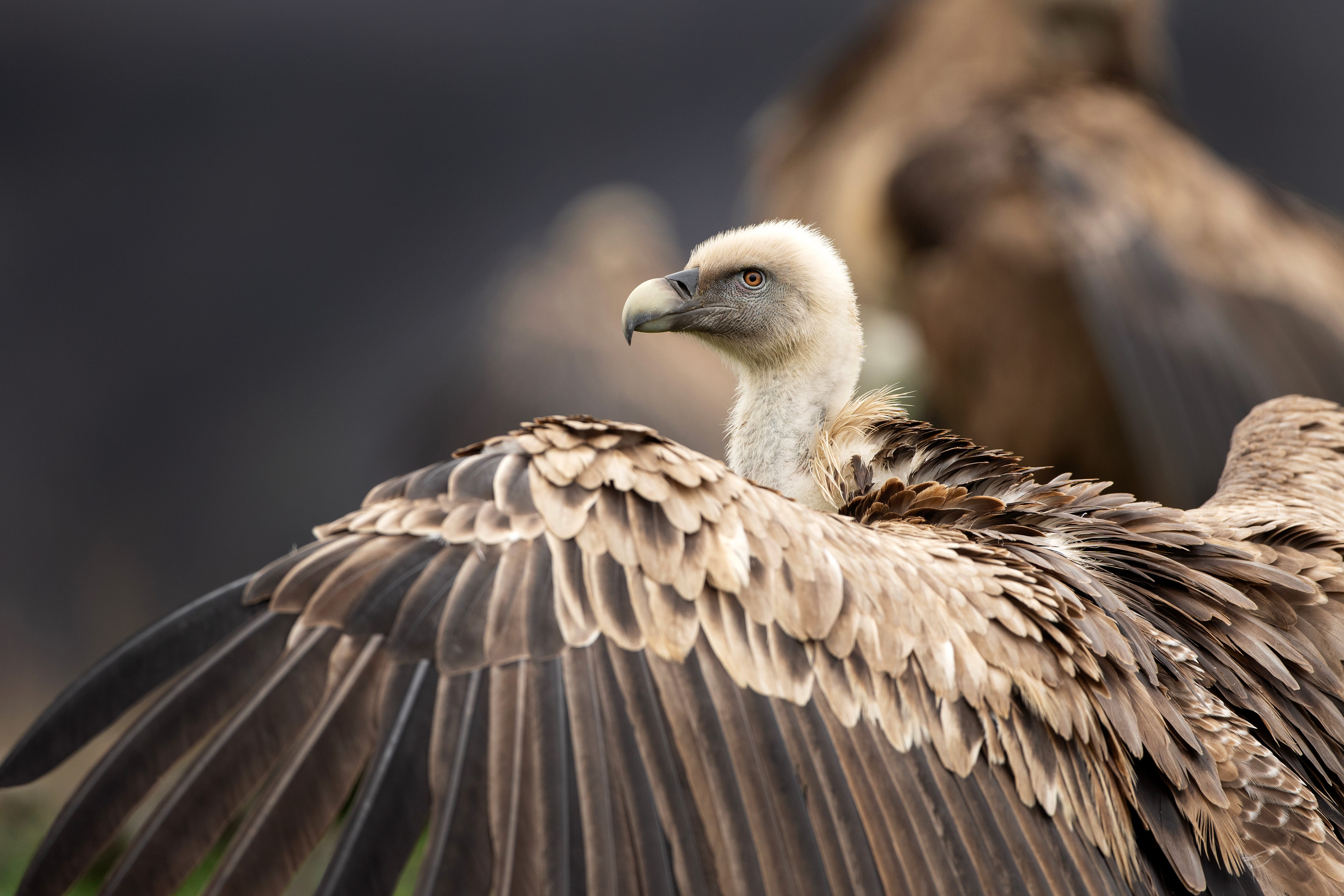
Very wide wings in the air, sharp eyes, exploring the surroundings. Leonated vultures have an unmistakable profile. They are able to detect the massacre for miles. That is their way of life, with the massacre as the only food. But not all the massacre is the same. “It is thought that he will eat the first thing a scavenger finds,” says Navarre biologist Eneko Arrondo Floristan, but we have seen that vultures have hobbies.”
In fact, Arrondo and her peers very precisely investigated the diet of the leonated vultures and obtained surprising results. They discover complex behavior that nobody expected. They have seen that the vultures of the north and the south have different eating habits and that when they go to the pastures of the area of Extremadura, they each maintain their habits. This is what they have called vulture culture in their article entitled “Vulture culture: dietary specialization of an obligate scavenger”.
In this study, financed by the Natural Park of the Royal Bardenas of Navarra and the Junta de Andalucía, GPS devices were installed to 30 sargos captured in the Royal Bardenas and to 35 captured in Cazorla (Jaén). These devices also had an accelerometer that allowed not only to know where the vultures were going, but also to know when they were left to eat.
For three years they have been investigating. Among ten researchers, they visited 4,000 points indicated by the accelerometers, analyzing the remains to determine what vultures ate in that place. “It has been a great job and it has cost us a lot, but we are very happy with the result,” says Arrondo. “No studies of this size have been done anywhere else: three years, 60 individuals, two populations, so many points…”
“The vulture diet was known at the population level, so we haven’t found anything new about the ingredients in the diet,” he explains. “But now, thanks to the accelerometers, we have been able to know what each accelerometer has eaten and when it has eaten.” And when you look at this data, you see that not everyone eats the same.
On the one hand, they have found differences between the sexes. Males prefer human resources, such as intensive livestock farming and landfills, while females rely more on resources from hunting or extensive livestock. This difference has not surprised them very much. “In other studies, it has been observed that there are differences in physical status, mobility, mortality…,” says Arrondo. “It’s curious, because in the case of vultures there is no sexual dimorphism, there are no morphological differences, and it could be thought that there would not be behavior either, but it’s not.”
In fact, other gender differences, such as their behavior in pup growth, are now being investigated. “They have clearly different roles and that has consequences, even in the way they search for food. Males tend to take more risks, resulting in more deaths.”
On the other hand, differences have also been found between the populations of Navarra and Jaén. This was also to be expected, as the resources available in both areas are different. “The Ebro Valley is a highly anthropometric area with abundant intensive livestock. In the Cazorla area, livestock farming is extensive and there are many cuttings,” explains Arrondo. Consequently, vultures in each place have a varied diet according to resources.
Dehesas, copious pantry
It has been a surprise what happens when they move to the hesa,” says Arrondo. In fact, another study published last year showed that the Saiak from all over the peninsula, as well as some French people go to the Dehesas from Extremadura, Castilla-La Mancha and Andalusia. “We didn’t expect this at all,” Arrondo says, much less in all populations.”
Five populations were analyzed (the French Pyrenees, the Catalan Pyrenees, the Ebro Valley, Cazorla and Cadiz) and it was found that all are going to dehesas. There they spend a very variable amount of time and return to the original colony. Some make a return trip of 1,500 km.
“All of us who marked in the bardenas went to the Dehesas. Some once a year, others several times a year, and others once during the investigation period, but they all went.” It is noteworthy that the journey takes place even with the offspring in the nest, lasting several days, and usually the females. In these cases, the pups are left with the males.
In addition to the five populations included in the study, there are others. “I dare say that all peninsular vultures pass through the pastures sooner or later,” says Arrondo.
“The Dehesas are vulture pantries,” he explains. There are alternating trees, meadows, crops and mountain areas, places rich in biodiversity and with varied and varied resources. In fact, there are many extensive, but also intensive, livestock, and many deer and wild boars. The latter have also increased in recent years.
I mean, vultures have everything and a lot in them. “This doesn’t happen in many places. In some places there may be a lot of food, but not varied,” says Arrondo. “Then, if you prefer a type of food, whatever it is, you will find dehesa.” And that's exactly what you've seen. Despite the availability of all types of food, vultures maintain their original eating habits.
Social learning
So vultures don't eat the first thing they find, at least if they can choose. And vultures have certain tastes according to their origin. So they say that vultures have a form of culture. “Of course, it has nothing to do with, for example, the fact that some chimpanzees teach others to use tools, but basically it’s something like this: some vultures learn from each other what to eat and where to eat. That is why we say that some cultural characteristics influence the vulture diet. This has been very striking and surprising. These birds are not as rich and salty as they seem.”
“They are not exactly social animals,” explains Arrondo. They don't have a social structure like wolves or lions. “I sometimes use the clan, it is not a very technical word, but I think it gives an idea: we know each other, we learn from each other, we behave more or less in a similar way, we are gregarious, but we do not have very close links…” In any case, “what is clear is that there is a transmission of information or social learning”.
Precisely, knowing when and where this learning takes place is one of the next objectives of Arrondo and its members: “We need to know if they learn from parents in the first months or when they join the colony (in most cases it is the same colony, but not always)...”
On the other hand, in recent years, the culture of vultures from scavengers has spread to attack live animals. In this latest research on the vulture diet, it was not possible to find out if the vultures went to the examination of the ingested in a while, so it was impossible to know whether these animals were alive or dead. But they investigated it earlier and calculated that the proven allegations affected one in a thousand animals.
In addition, according to Arrondo, it would be necessary to analyze carefully what is behind these proven cases: “For example, a prolonged delivery, where the animal has lost a lot of blood and is very weak. We'll say this animal is alive because the heart beats it, but it's like it's ecologically dead and for a couch. And it follows that vultures are becoming predators doesn't make sense. It may ever happen, but it is absolutely exceptional.”
The issue began in the mad cow era. Feeders were closed for slaughter and carcasses of livestock were banned in the camp. “It’s true that there was a shortage of carrion at the time, but since then these prohibitions have gone down, and now it’s not true that vultures are hungry,” Arrondo says.
Furthermore, animal carcass treatment policies have a major impact on vultures. A few years ago they realized that the Black and Leonate vultures did not cross the border between Portugal and Spain. Without geographic boundaries, they saw that they didn't cross that invisible administrative border. And the reason is that on either side of the border you play differently with animal carcasses.
Since the mad cow crisis, Spain has accepted the abandonment of cattle that die in the countryside. In Portugal they must be buried or incinerated. “Vultures have learned that it is not worth going to Portugal because there it is harder to find food,” says Arrondo.
In relation to these policies, Arrondo considers that “in the case of extensive livestock farming there is no justification for the removal or incineration of carcasses”. Its economic cost is high and harms the environment. Vultures provide this service for free. That is why, among others, they are such important species.
Best scavengers
They are the paradigm of the scavengers,” says Arrondo. “They are the only vertebrates that feed exclusively on the massacre and, by their specialization, are the most effective for its destruction. When vultures are present, the massacre lasts much less. Vultures are key.”
Remember what happened in India. In the past year, millions of alimoches have disappeared, poisoned by the phasing of diclophene. “There were a lot of massacres that led to the proliferation of wild dogs. Those wild dogs had rage, and the death of the people caused by this disease was tremendous.”
Diclofenac eliminated 95% of Indian and Pakistani vultures in the 1990s. There, veterinary drug collection was obtained. However, it can be used in Europe. In 2021, a group of them, in a letter published in Science, asked that they should be in Europe.
In this sense, vulture dependence on intensive livestock resources poses some risks. “Theoretically, the carcasses of intensive livestock cattle cannot be abandoned on slaughter. But, for one thing or another (sometimes illegally, sometimes unintentionally), there is always something left, and it is so intensive that that ‘something’ ends up being a lot. And vultures eventually feed on those resources.”
They have also seen its consequences: northern vultures have worse health than southern vultures. “They don’t seem to be bad, either in size or weight, but if you look at other parameters like corticosteroid level or telomeres, we’ve seen the northern ones are more stressed.” In addition, by drawing closer to the dangers caused by man, more deaths, for example, are caused by electrocutes and vehicles on the road.
Taking these things into account is essential to care for vultures. For example, it is clear that extensive livestock farming is good for vultures. “Everything should be balanced and decide what should be encouraged,” says Arrondo.
And it stresses the importance of keeping the dehesas. “As we have seen, these landscapes, despite being anthropized environments, are today basic for trials. The preservation of this landscape is unbeatable for trials and for many more”.

Gai honi buruzko eduki gehiago
Elhuyarrek garatutako teknologia



